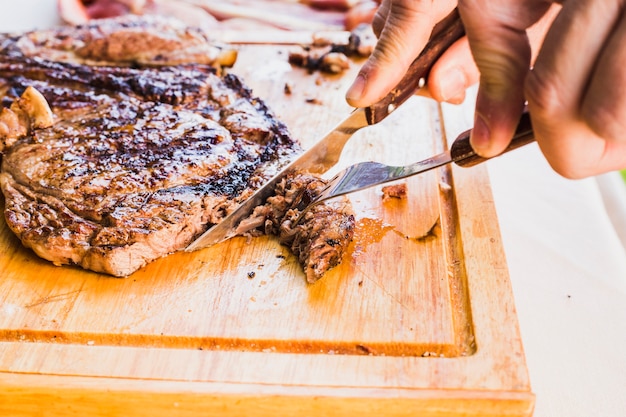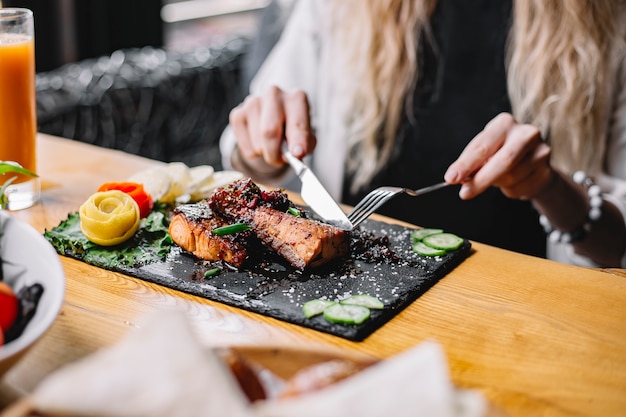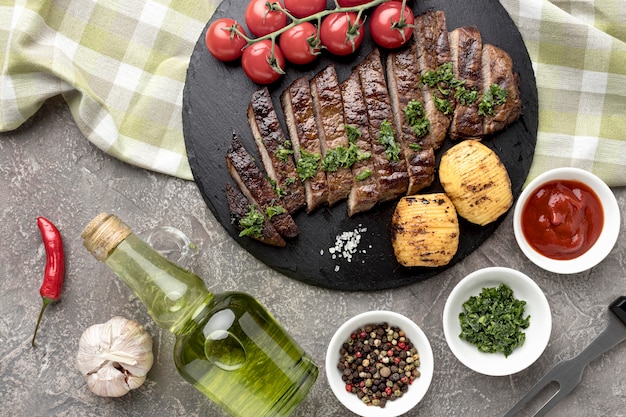Let's talk steak, my friends. Not the flimsy, supermarket-variety stuff. I'm talking about a glorious, thick-cut ribeye – a piece of meat that sings with flavour and boasts beautiful marbling. The kind of steak that makes you feel like you're dining at a fancy restaurant, but you've done the magic yourself in your own kitchen. You know, the kind of steak that makes you think, "I can totally do this!"
And you know what? You absolutely can! I used to be petrified of cooking steak. I thought it was some kind of culinary black magic reserved for seasoned chefs. But then I realized, it's not complicated at all. It just takes a few key things: the right cut of meat, a reliable pan, and a bit of know-how.
So, grab a pint (or a glass of something red), crank up some good tunes, and let's get cooking. This is my guide to making a perfect ribeye steak on the stovetop, even if you're a complete kitchen novice.
(Part 1) choosing the right ribeye

First things first, you need the star of the show: a magnificent ribeye. It's a fantastic choice for beginners because it's naturally forgiving. Ribeyes have that lovely marbling, streaks of fat running through the meat, which helps them stay juicy even if you're a bit rough around the edges in the kitchen.
How to Pick the best steak
When you're at the butcher's counter, look for a ribeye that's at least an inch thick. You want a steak with some heft, not something thin and flimsy. The marbling is key – you're looking for those beautiful streaks of fat, like little highways running through the meat. This fat is what gives the ribeye its juicy, melt-in-your-mouth texture and incredible flavour.
The Importance of Marbling
Imagine it like this: when you cook the steak, you're essentially rendering that fat, allowing it to melt and infuse the meat with its deliciousness. It's like magic! So, don't be shy of a little fat; it's your friend!
What to Avoid
If you can, avoid steaks with any discoloration or patches of brown or grey. Those are signs the meat has been mishandled, and it might not taste as good.
(Part 2) Preparing the Steak for Cooking

Now that you've got your perfect ribeye, it's time to get it ready for the stovetop. I'm a big believer in letting the steak come to room temperature before cooking. It's all about achieving that even cooking, and taking it straight from the fridge means certain parts will be colder than others, leading to uneven cooking.
Bringing Your Steak to Room Temperature
Take the steak out of the fridge about 30 minutes before you plan to cook it. This gives it time to warm up and ensures a more even cooking experience. It also makes the steak more tender because the muscles relax. Don't worry if you forget, though; it's not a culinary disaster.
Seasoning Your Steak
Now for the magic touch: seasoning. A simple salt and pepper combo is a classic for a reason. I always use freshly ground black pepper, but you can use whatever you prefer. Don't go overboard with the salt; just a light sprinkle is all you need.
Alternative Seasonings
If you're feeling adventurous, you can experiment with other seasonings. Garlic powder, onion powder, paprika, even herbs like thyme or rosemary can add a nice touch. Just remember, less is more when it comes to seasoning.
Don’t Overdo the Seasoning
A good steak is all about the natural flavour of the meat, so don't bury it under a mountain of spices. You're just adding a touch of extra flavour, not creating a flavour explosion.
(Part 3) Choosing the Right Pan

Choosing the right pan is crucial for cooking steak. You want something that heats up quickly and evenly, and is big enough for your steak without crowding it.
What Type of Pan to Use
Cast iron is the classic choice for cooking steak, and it's my go-to. It retains heat beautifully, giving you that perfect sear. But a heavy-bottomed stainless steel pan will also work well. Just avoid non-stick pans – they're not ideal for achieving those delicious grill marks.
Preheating Your Pan
Once you've got your chosen pan, preheat it over medium-high heat for about 5-7 minutes. You want the pan to be really hot before you add the steak. You'll know it's ready when it's smoking slightly.
(Part 4) Cooking the Steak
This is where the fun begins! But don't worry, it's not as scary as it might seem.
Adding the Steak to the Pan
Once your pan is smoking hot, carefully place the steak in the pan. You want to hear a satisfying sizzle as it hits the hot surface. Don't overcrowd the pan with too many steaks, give them space to cook evenly.
How Long to Cook Each Side
Now, here's where things get a bit tricky, but I'll guide you through it. This is for a medium-rare steak, my personal preference. Cook the steak for 2-3 minutes per side to get that beautiful sear.
Flipping Your Steak
Here's the important bit: flip the steak only once. It's tempting to peek and fiddle, but resist! Let it cook undisturbed for those first 2-3 minutes. You want those gorgeous grill marks, and they'll only form if you give the steak time to brown properly on each side.
Using a meat thermometer
To ensure your steak is cooked to your liking, use a meat thermometer. The internal temperature for a medium-rare steak is 130-135°F (54-57°C).
Adjusting cooking time
If you prefer a more well-done steak, cook it for an extra minute or two on each side. Remember, you'll be taking it off the heat to rest, and the internal temperature will continue to rise slightly.
(Part 5) Resting the Steak
Once your steak is cooked to perfection, it's crucial to let it rest for about 5-10 minutes before slicing and serving. It's a simple step, but it makes a world of difference in terms of flavour and tenderness.
Why Resting is Important
During the resting period, the juices redistribute throughout the steak. This means the meat will be more juicy and tender, and you'll essentially lock in all that delicious flavour.
How to Rest Your Steak
To rest the steak, transfer it to a cutting board and cover it loosely with foil. This will help keep it warm and prevent it from getting cold too quickly.
(Part 6) Serving Your Steak
Now, this is the part where you get to enjoy the fruits of your labour.
Cutting the Steak
Cut the steak against the grain. This means slicing it perpendicular to the muscle fibers, which makes the meat more tender and easier to chew.
What to Serve with Your Steak
There are countless options for what to serve with your steak. Classic sides like mashed potatoes, roasted vegetables, or a simple salad are always a good choice. But you can also be a bit more adventurous and try something different, like a creamy polenta or asparagus with lemon and garlic.
(Part 7) Tips and Tricks
Here are a few extra tips to help you cook the perfect ribeye steak every time.
Don't Be Afraid to Experiment
Don't be afraid to experiment with different seasonings, sides, and cooking methods. One of the best things about cooking steak is that there's no right or wrong way to do it. It's all about finding what you like.
Using a cast iron pan
If you're using a cast iron pan, make sure to season it properly before you cook. This will help prevent sticking and give your steak a nice, crispy sear.
Adding Butter to the Pan
Just before you take the steak off the heat, add a knob of butter to the pan. It will melt and create a flavorful sauce that you can spoon over your steak.
Using Garlic and Herbs
Add a few cloves of garlic to the pan with the butter for an extra flavour boost. You can also add fresh herbs like thyme or rosemary to the pan.
Finishing Touches
For a final touch, you can add a few drops of balsamic vinegar or lemon juice to the pan to create a tangy sauce.
(Part 8) Common Mistakes to Avoid
There are a few common mistakes people make when cooking steak. Here are a few things to watch out for.
Overcrowding the Pan
Don't overcrowd the pan with too many steaks. This will lower the temperature of the pan and prevent the steaks from getting a good sear.
Flipping the Steak Too Often
Only flip the steak once. Flipping it multiple times will dry it out and make it tough.
Not Resting the Steak
Don't forget to rest the steak. It's essential for creating a juicy and tender steak.
Not Using a Meat Thermometer
Use a meat thermometer to ensure your steak is cooked to your liking. This will prevent you from overcooking or undercooking the steak.
(Part 9) FAQs
Here are some frequently asked questions about cooking steak on the stovetop.
1. What if I don't have a cast iron pan?
If you don't have a cast iron pan, a heavy-bottomed stainless steel pan will work just fine. Just make sure it's preheated well before you add the steak.
2. What is the best way to clean a cast iron pan?
To clean your cast iron pan, simply wash it with hot water and a scrub brush. You don't need to use soap. After washing, dry the pan thoroughly and rub a thin layer of oil over the surface. This will help prevent rust.
3. Can I use a grill pan for stovetop cooking?
Yes, you can use a grill pan for stovetop cooking. It will give the steak those delicious grill marks. Just make sure the pan is preheated well before you add the steak.
4. How do I tell if my steak is done?
The best way to tell if your steak is done is to use a meat thermometer. However, you can also use the touch method. If you press the steak with your finger, it should feel firm for a well-done steak, springy for a medium steak, and soft for a rare steak.
5. How can I make my steak more tender?
Here are a few tips for making your steak more tender:
- Use a good quality cut of meat.
- Let the steak come to room temperature before cooking.
- Don’t overcook the steak.
- Rest the steak for 5-10 minutes before slicing and serving.
I hope this guide has helped you understand how to make the perfect ribeye steak on the stovetop. Now go on, give it a try! You might be surprised at how easy it is! Remember, practice makes perfect. And don't be afraid to experiment and have fun! After all, cooking is meant to be enjoyable. Happy cooking!
Everyone is watching

Corn on the Cob: The Ultimate Guide to Perfectly Cooked Ears
Healthy MealsAh, corn on the cob. Just the name evokes images of sunny days, barbecues, and that sweet, juicy flavour that ...

Perfect Pork Roast Oven Cooking Time: A Guide to Delicious Results
Healthy MealsThere's something truly satisfying about a perfectly roasted pork. The aroma alone is enough to make your mout...

Ham Cooking Time: How Long to Bake, Smoke, or Boil a Delicious Ham
Healthy MealsAh, ham. It's a classic, isn't it? A real crowd-pleaser, especially around holidays. And when done right, it'...

Scallops: The Ultimate Guide to Perfect Cooking
Healthy MealsAh, scallops. Those delicate, sweet, and utterly delicious morsels of the sea. They hold a special place in my...

Spaghetti Squash: The Ultimate Guide to Cooking and Serving
Healthy MealsRemember that time you saw spaghetti squash at the supermarket, looking all bumpy and strange, and thought, "W...
